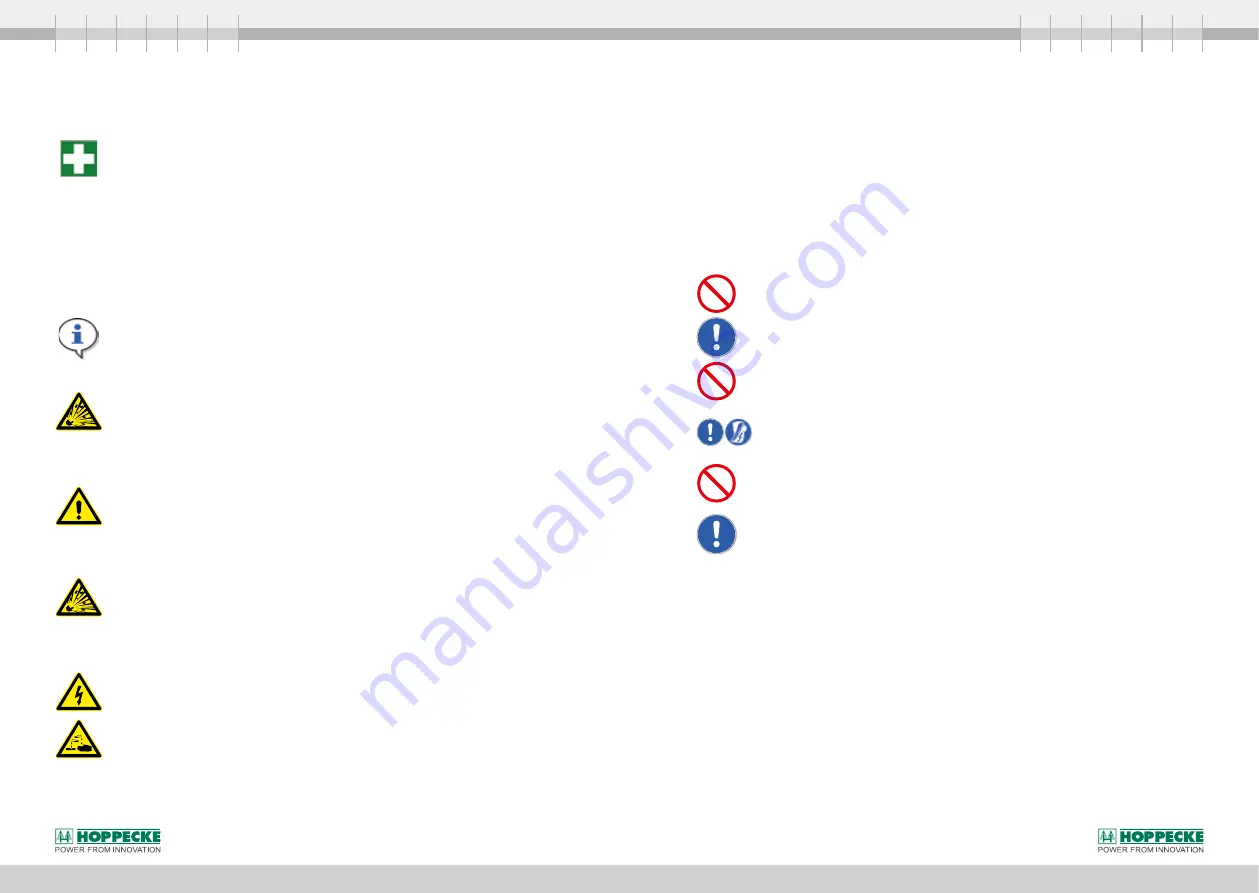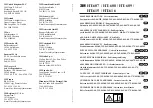
10
11
Assembly and operating manual aquagen
7149029926 V1.3 (09.2018)
Assembly and operating manual aquagen
7149029926 V1.3 (09.2018)
1.4 Safety Precautions
1.4.1 Sulphuric Acid
Sulphuric acid can cause severe chemical burns and injuries.
First aid measures
Electrolyte on the skin:
Dab off the acid using a cotton or paper towel, do not rub it off. Rinse the affected parts under run-
ning water for a longer time. Remove soaked pieces of clothing beforehand. In doing so, preferably
avoid contact with body parts that are not affected. After rinsing, wash thoroughly using soap.
Electrolyte in the eye:
Rinse the eye under running water or use the eyewash bottle. Avoid excessive water pressure.
Consult an ophthalmologist immediately.
Electrolyte in the body:
Immediately consult a doctor or go to a hospital. Until the doctor arrives: depending on degree
and location of the chemical burn, rinse with magnesium oxide suspension, or drink it. If available,
also use water with dissolved bicarbonate (sodium carbonate).
Also see ZVEI leaflet “Safety data sheet for battery acid (diluted sulphuric acid)” in the annex.
1.4.2 Explosive Gases
An explosive mixture of hydrogen/oxygen can escape from lead acid batteries. In case of an
explosion of the mixture, severe personal injuries can occur.
- Always wear the prescribed protective clothing (safety goggles, suitable protective gloves and
safety boots, see
chapter 1.3
).
- Use proper tools only (not “striking sparks”, with insulated handles etc.).
- Prevent any ignition sources such as sparks, flames, and electric arcs.
-
Prevent electrostatic discharge, wear cotton clothes and ground yourself if necessary if you
are working directly on the batteries.
Danger!
In case of fire, only use water or CO
2
to extinguish it!
Switch off the battery charging voltage first!
During extinguishing work, use a respirator with independent breathing air supply.
Do not point the fire extinguisher directly on the battery (batteries) to be extinguished. There is a
risk that the battery housing will crack due to thermal tension.
Moreover, there is a risk of explosion due to possible static charges on the battery surface.
In order to minimise electrostatic charges on the battery surface, extinguish at short intervals.
There is a risk of explosions due to possible static charges on the battery surface.
Toxic gases might occur when plastic materials are combusting. In this case, leave the fire ground
as soon as possible if you are not wearing a respirator.
When using extinguishing water/foam, there is a risk of a short circuit.
When using extinguishing water, there is a risk of reactions with the electrolyte and, as a conse-
quence, severe squirting. Therefore, wear acid-proof protective clothing.
1.4.3 Electrostatic Discharges
All lead acid batteries develop hydrogen and oxygen gas, known as oxyhydrogen, during operation but mainly
during charging. These gases are escaping from the batteries into the surroundings of the battery. For the natu-
ral or technically supported ventilation which always has to be provided, you have to assume that an ignitable
hydrogen-oxygen gas mixture is only present in the vicinity of the battery cell openings.
An ignitable hydrogen-oxygen gas mixture is always present inside the battery housing itself. This applies inde-
pendent of the battery technology, design or manufacturer and is typical for all lead acid batteries.
The energy which is required for the ignition of oxyhydrogen is very low and can, for example, be released or
introduced as follows:
Open flames or fire, smouldering sparks or flying sparks during grinding work, electrical sparks due to switches
or fuses, temperature > 300 °C and – an often underestimated cause – electrostatic discharges.
Measures to prevent oxyhydrogen ignitions due to electrostatic discharges
The development of electrostatic discharges on the battery or on your body or your clothing can be prevented
if you observe the following:
Do not wipe the battery with a dry cloth, in particular cloth made of synthetic materials!
Rubbing on plastic surfaces (battery housings are usually made of plastic) generates electrostatic
charges.
Clean the battery surfaces only with cotton cloths which are moistened with water. No charges
develop when wiping with a damp cotton cloth.
When working on batteries, you must prevent your clothes (e.g. made of wool) from rubbing on
the battery. This could cause the development of electrostatic charges on the battery housing or
your body or clothes.
Wear suitable shoes and clothes which prevent the occurrence of electrostatic charges due to
their special surface resistivity. This can prevent the development of electrostatic charges on
your body or clothes.
Do not remove labels on the battery without special safety precautions. Pulling or tearing plastic
labels off plastic surfaces can cause electrostatic charges which can ignite oxyhydrogen when
discharging.
Before removing the label, wipe the battery with a wet cloth.
According to EN50272-2, the following requirements apply to the battery room:
The floor area in which a person is within arm’s reach to the battery must be conductive in such a way that
electrostatic charging is avoided. The leak resistance to a grounded point measured according to IEC 61340-
4-1 must be less than 10 Mohm. On the other hand, the floor must be sufficiently insulated for the protection
of persons. Therefore, the leak resistance of the floor against a grounded point measured according to IEC
61340-4-1 must be:
For battery voltages
≤
500 V: 50 kohm
≤
R
≤
10 Mohm;
For battery voltages
>
500 V: 100 kohm
≤
R
≤
10 Mohm.





























